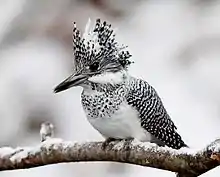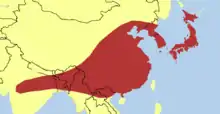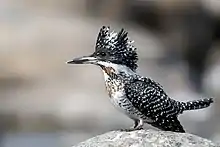Crested kingfisher
The crested kingfisher (Megaceryle lugubris) is a very large kingfisher that is native to parts of southern Asia, stretching eastwards from the Indian Subcontinent towards Japan. It forms a species complex with the other three Megaceryle species.[2]
| Crested kingfisher | |
|---|---|
 | |
 | |
| Male (top) and female (bottom) M. lugubris subsp. pallida at Asahikawa city in Japan | |
| Scientific classification | |
| Domain: | Eukaryota |
| Kingdom: | Animalia |
| Phylum: | Chordata |
| Clade: | Dinosauria |
| Class: | Aves |
| Order: | Coraciiformes |
| Family: | Alcedinidae |
| Subfamily: | Cerylinae |
| Genus: | Megaceryle |
| Species: | M. lugubris |
| Binomial name | |
| Megaceryle lugubris (Temminck, 1834) | |
 | |
| approximate distribution | |
Taxonomy
The first formal description of the crested kingfisher was by the Dutch zoologist Coenraad Jacob Temminck in 1834 under the binomial name Alcedo lugubris.[3][4] The current genus Megaceryle was erected by the German naturalist Johann Jakob Kaup in 1848.[5] Megaceryle is from the Ancient Greek megas, "great", and the existing genus Ceryle. The specific name lugubris is the Latin word for "mournful".[6]
There are four subspecies:[7]
- M. l. continentalis (Hartert, 1900) – Himalayas, from Afghanistan to Bhutan
- M. l. guttulata (Stejneger, 1892) – Bhutan to Vietnam, China and North Korea
- M. l. pallida (Momiyama, 1927) – northern Japan (Hokkaido), southern Kuril Islands
- M. l. lugubris (Temminck, 1834) – central and southern Japan (Honshu, Shikoku and Kyushu)
Description
The crested kingfisher is a very large 41–43 cm (16–17 in) black and white kingfisher with a shaggy crest.[8] It has evenly barred wings and tail. It lacks a supercilium and has a spotted breast, which is sometimes mixed with rufous.

Range and habitat

It is resident in the Himalayas and mountain foothills of northern India, Bangladesh, northern Indochina, Southeast Asia and Japan. This bird is mainly found in mountain rivers and larger rivers in the foothills of mountains.
Behaviour
Breeding
The nest is a burrow excavated into a vertical bank in a forest. It can be by a stream or a ravine or can be up to 1.5 km (0.93 mi) away from water. The burrow is dug by both sexes using their feet and bills. It is 10–15 cm (3.9–5.9 in) wide and 2–3 m (6 ft 7 in – 9 ft 10 in) in length. The clutch of 4-7 eggs is incubated only by the female. The nestlings are fed by both parents for around 40 days before they fledge.[8]
Status
A decline has been noted in northeastern China. Declines have been linked to habitat destruction.
References
- BirdLife International (2016). "Megaceryle lugubris". IUCN Red List of Threatened Species. 2016: e.T22683620A92992024. doi:10.2305/IUCN.UK.2016-3.RLTS.T22683620A92992024.en. Retrieved 12 November 2021.
- Woodall, P.F. (2017). del Hoyo, J.; Elliott, A.; Sargatal, J.; Christie, D.A.; de Juana, E. (eds.). "Crested Kingfisher (Megaceryle lugubris)". Handbook of the Birds of the World Alive. Lynx Edicions. doi:10.2173/bow.crekin1.01. S2CID 226015686. Retrieved 2 June 2017.
- Temminck, Coenraad Jacob (1838) [1834]. Nouveau recueil de planches coloriées d'oiseaux, pour servir de suite et de complément aux planches enluminées de Buffon (in French). Vol. 4. Paris: F.G. Levrault. Plate 548 text. The 5 volumes were originally issued in 102 parts, 1820-1839.
- Peters, James Lee, ed. (1945). Check-list of Birds of the World. Vol. 5. Cambridge, Massachusetts: Harvard University Press. p. 166.
- Kaup, Johann Jakob (1848). "Die Familie der Eisvögel (Alcedidae)". Verhandlungen des Naturhistorischen Vereins für das Großherzogthum Hessen und Umgebung (in German). 2: 68. OCLC 183221382.
- Jobling, James A. (2010). The Helm Dictionary of Scientific Bird Names. London: Christopher Helm. pp. 232, 245. ISBN 978-1-4081-2501-4.
- Gill, Frank; Donsker, David, eds. (2017). "Rollers, ground rollers & kingfishers". World Bird List Version 7.2. International Ornithologists' Union. Retrieved 28 May 2017.
- Fry, C. Hilary; Fry, Kathie; Harris, Alan (1992). Kingfishers, Bee-eaters, and Rollers. London: Christopher Helm. pp. 229–230. ISBN 978-0-7136-8028-7.
External links
